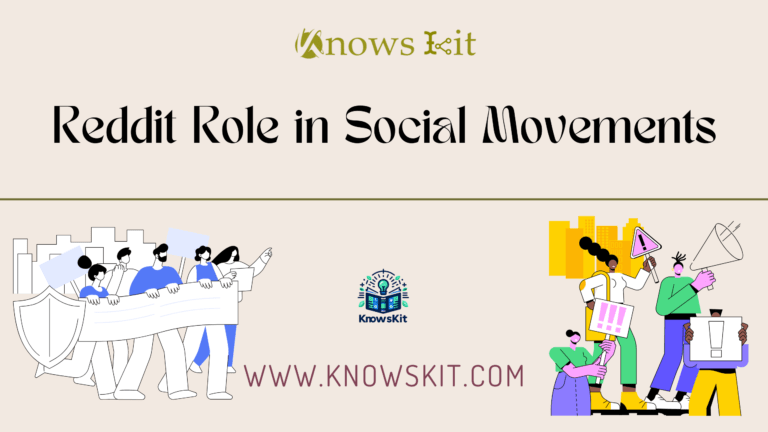In the digital age, social media etiquette plays a pivotal role in how we interact online. This guide delves into the nuanced world of social media etiquette, exploring its importance and providing practical tips for personal and professional conduct.
In the bustling realms of Twitter, Instagram, LinkedIn, and beyond, understanding and practicing proper Social Media Etiquette is crucial. This etiquette isn’t just about avoiding faux pas; it’s about fostering respectful, engaging, and productive online environments. Whether for personal branding or professional networking, the way we present ourselves on these platforms can have lasting impacts.
Understanding Social Media Etiquette
![Navigating Social Media Etiquette [2024 Exquisite Analysis] 2 Diverse people engaging in respectful social media interactions with speech bubbles and emojis](https://www.knowskit.com/wp-content/uploads/2024/01/the-art-of-respectful-online-communication-1024x585.png)
Social media etiquette is a crucial aspect of navigating our interconnected digital world. It’s about understanding and implementing a set of unwritten rules that govern our interactions on various social platforms. This etiquette ensures our online exchanges are respectful, productive, and enjoyable. Here, we delve into what social media etiquette means, its core principles, and how to adapt to different social media platforms.
What is Social Media Etiquette?
Social media etiquette refers to the code of conduct that guides our behavior on digital platforms. It encompasses a range of practices and norms that help maintain harmony and respect in online communities. Whether you’re tweeting, posting on Facebook, sharing photos on Instagram, or networking on LinkedIn, each interaction should be guided by an understanding of these unspoken rules.
Why Is Social Media Etiquette Important?
In today’s digital age, our online presence can have a profound impact on our personal and professional lives. A single post can shape public perception, influence career opportunities, and affect personal relationships. Practicing good social media etiquette helps in:
- Building a Positive Online Reputation: How you interact online paints a picture of your personality and values. Maintaining a respectful and considerate online presence helps in building a positive digital footprint.
- Preventing Misunderstandings: Clear, respectful communication reduces the risk of misunderstandings and conflicts which are common in text-based interactions.
- Fostering Professional Relationships: For professionals, social media can be a powerful networking tool. Proper etiquette can help in forming and maintaining valuable connections.
Core Principles of Online Communication
![Navigating Social Media Etiquette [2024 Exquisite Analysis] 3 Social Media Etiquette](https://www.knowskit.com/wp-content/uploads/2024/01/image-44-1024x680.png)
Social media etiquette is anchored in a few core principles that transcend all platforms:
- Respect: This is the cornerstone of all online interactions. Treat others as you would like to be treated. Avoid derogatory comments, personal attacks, or any form of cyberbullying.
- Authenticity: Be genuine in your interactions. Authenticity fosters trust and creates more meaningful connections.
- Privacy: Respect your privacy and the privacy of others. Think twice before sharing personal information and avoid posting about others without their consent.
The Do’s and Don’ts of Social Interaction
To further clarify, here’s a breakdown of general do’s and don’ts:
- Do’s:
- Be kind and courteous.
- Share content that adds value.
- Engage in constructive discussions.
- Fact-check information before sharing.
- Use appropriate language and tone.
- Don’ts:
- Avoid sharing offensive or inflammatory content.
- Don’t engage in arguments or spread negativity.
- Refrain from posting false information.
- Avoid sharing overly personal details in public forums.
- Don’t infringe on others’ privacy.
Adapting to Different Social Media Platforms
![Navigating Social Media Etiquette [2024 Exquisite Analysis] 4 Professional etiquette on social media platforms with individuals engaging on LinkedIn.](https://www.knowskit.com/wp-content/uploads/2024/01/professionalism-in-the-digital-realm-1024x585.png)
Each social media platform has its unique culture and etiquette:
- LinkedIn: Maintain a professional tone. Share content related to your industry, and engage in networking professionally.
- Facebook: Suitable for more personal and casual interactions. However, remain respectful and considerate in comments and shares.
- Twitter: Given its public and fast-paced nature, be concise yet thoughtful. Engage in trends responsibly.
- Instagram: Focus on visual content. Be mindful of the images and stories you share and how they reflect on your brand.
In summary, understanding and practicing proper social media etiquette is vital in the digital age. It helps in building a positive online presence, fostering healthy interactions, and ensuring a respectful digital environment for all. As we continue to navigate the vast world of social media, let’s keep these guidelines in mind for more enriching and positive online experiences.
Professional Social Media Etiquette
Professional social media etiquette is about more than just avoiding embarrassing blunders. It’s a strategic approach to online interactions that can enhance your career and business prospects. This section delves into the intricacies of maintaining professionalism on social media, covering aspects like engaging with colleagues and superiors, managing your professional image, and the unique etiquette for businesses on these platforms.
Navigating Professional Boundaries Online
![Navigating Social Media Etiquette [2024 Exquisite Analysis] 5 Social Media Etiquette](https://www.knowskit.com/wp-content/uploads/2024/01/image-45-1024x664.png)
Engaging professionally on social media is a balancing act. Here are some key guidelines:
- Respecting Hierarchies and Colleagues: Just as in the physical workplace, it’s important to respect hierarchies and colleagues online. This means being mindful of how you interact with superiors and peers, and ensuring your comments and posts are appropriate and respectful.
- Avoiding Oversharing: While it’s great to show personality, there’s a fine line between being personable and oversharing. Keep your posts professional and relevant to your industry. Remember, your colleagues and potential employers are likely viewing your content.
- Professional Branding: Your social media profiles are a reflection of your professional brand. Ensure that your content, from your LinkedIn articles to your tweets, aligns with the image you want to project in your professional sphere.
Managing Your Professional Image
A well-managed online presence can be a tremendous asset in your professional life:
- Consistency Across Platforms: Ensure that your professional image is consistent across different social media platforms. This includes having a professional profile picture and a bio that reflects your current role and expertise.
- Thoughtful Content Sharing: Share content that is relevant to your industry and adds value to your network. This could include articles, insights, and thoughtful commentary on industry trends.
- Engaging with Thought Leadership: Participate in discussions led by industry leaders. Commenting on and sharing thought-provoking content can position you as an engaged and knowledgeable professional.
Social Media Etiquette for Businesses
![Navigating Social Media Etiquette [2024 Exquisite Analysis] 6 Person reviewing their social media profile for digital footprint management.](https://www.knowskit.com/wp-content/uploads/2024/01/curating-your-digital-identity-1024x585.png)
For businesses, social media is a critical tool for brand building, customer engagement, and reputation management.
- Brand Voice and Communication: Establish a clear and consistent brand voice. Whether it’s professional, friendly, informative, or a mix, your voice should align with your brand’s values and target audience.
- Customer Interaction: Engage with customers respectfully and professionally. Address concerns, provide helpful responses, and thank customers for their feedback. How you handle criticism or complaints on social media can significantly impact your brand’s perception.
- Content Strategy: Develop a content strategy that balances promotional material with content that adds value to your audience. This could include industry insights, helpful tips, or highlighting company culture.
Case Study: Professional Mishaps on Social Media
Consider the case of a company that faced public backlash due to an insensitive tweet. This serves as a reminder of the potential repercussions of not adhering to professional social media etiquette. It highlights the need for businesses to be mindful of their content and the importance of having a crisis management plan in place.
Professional social media etiquette is essential for building and maintaining a positive online presence. Whether you’re an individual navigating your career or a business engaging with your audience, adhering to these guidelines will help foster a professional and respectful digital environment conducive to growth and success.
Personal Social Media Use
![Navigating Social Media Etiquette [2024 Exquisite Analysis] 7 Social Media Etiquette](https://www.knowskit.com/wp-content/uploads/2024/01/image-46-1024x660.png)
In the realm of personal social media use, etiquette plays a pivotal role in shaping our digital identity and interactions. This section explores how to balance personal expression with the norms and expectations of online platforms, focusing on personal branding, cultural sensitivity, and privacy concerns.
Personal Branding and Online Etiquette
Personal branding on social media is about curating an online presence that accurately reflects your personality, interests, and values. It’s a delicate balance between being authentic and mindful of how your content might be perceived.
- Authenticity and Genuine Engagement: Be true to yourself. Authenticity resonates with others and helps in building genuine connections. Share your interests, celebrate your achievements, and be honest in your interactions.
- Mindful Sharing: Every post contributes to your digital footprint. Think about the potential long-term impact of what you share. This includes being cautious about sensitive topics or content that might be misinterpreted.
- Personal vs. Public: Decide what aspects of your life you’re comfortable sharing publicly. It’s okay to keep certain parts of your life private or restricted to close friends and family.
Cultural Sensitivity and Global Communication
Social media platforms connect users from all around the world, making cultural sensitivity crucial.
- Be Mindful of Cultural Differences: Posts that are acceptable in one culture may be offensive in another. Strive to understand and respect these differences, especially when engaging with a global audience.
- Inclusivity and Respect: Use inclusive language and avoid stereotypes or generalizations. Remember that social media is a diverse space, and being respectful of all cultures is key to positive interactions.
Privacy and Security Concerns
![Navigating Social Media Etiquette [2024 Exquisite Analysis] 8 Diverse group engaging in constructive online debate on a social media platform](https://www.knowskit.com/wp-content/uploads/2024/01/fostering-constructive-digital-discussions-1024x585.png)
In an age where data privacy is a significant concern, it’s essential to be mindful of privacy settings and the information you share online.
- Manage Privacy Settings: Regularly review your privacy settings to control who can see your posts and personal information. Different platforms offer various levels of privacy customization.
- Think Before You Share: Be cautious about sharing personal details like your location, financial information, or family matters. Once something is online, it can be difficult to take it back.
- Respecting Others’ Privacy: Just as you value your privacy, respect others’ too. Avoid sharing photos or information about others without their consent.
Personal social media use requires a balance between authentic self-expression and consideration for privacy, cultural sensitivity, and the digital footprint we leave. By adhering to these etiquette guidelines, we can enjoy the benefits of social media while maintaining a positive and respectful online presence.
Overcoming Common Challenges
Navigating social media can often present challenges, ranging from managing conflicts to keeping up with the ever-changing landscape of digital etiquette. This section provides insights and strategies for dealing with some of the most common issues faced by users on social media platforms.
Dealing with Conflict and Misunderstandings
Social media, with its mix of public forums and direct messaging, can sometimes lead to misunderstandings and conflicts. Here’s how to handle such situations:
- Stay Calm and Respectful: When encountering a disagreement or negative comment, it’s important to remain calm. Responding in anger or haste can escalate the situation and harm your online reputation.
- Clarify Misunderstandings: If a post or comment is misinterpreted, politely clarify your intent. A simple explanation can often resolve a misunderstanding.
- Choose Your Battles: Not every comment or post warrants a response. Sometimes, ignoring a troll or a negative comment is the best course of action.
- Private vs. Public Responses: If a discussion becomes heated or personal, consider taking it to a private message. This can help de-escalate the situation and allows for more nuanced communication.
- Use Platform Tools: Utilize the tools provided by social media platforms, such as blocking or reporting, if you encounter harassment or inappropriate behavior.
Keeping Up with Evolving Etiquette Norms
Social media is constantly evolving, and so are the norms and etiquette that govern it. Staying current can be challenging but is necessary for effective and respectful communication.
- Stay Informed: Follow reputable sources, blogs, and influencers who provide updates on social media trends and best practices.
- Adapt and Learn: Be open to changing your behavior in response to new norms. For example, a practice that was acceptable a few years ago might be frowned upon today.
- Participate in Online Communities: Engaging in forums or groups related to social media can provide insights into current trends and user expectations.
- Regularly Review Your Practices: Periodically review your social media activity. Reflect on your interactions and posts to ensure they align with current standards of etiquette.
Tips and Best Practices
![Navigating Social Media Etiquette [2024 Exquisite Analysis] 9 Person learning social media etiquette from online educational resources.](https://www.knowskit.com/wp-content/uploads/2024/01/educating-yourself-in-digital-communication-1024x585.png)
Social media etiquette, while seemingly intuitive, can often be complex and nuanced. This section offers practical tips and best practices to ensure that your interactions on various platforms are both respectful and effective. These guidelines will help you navigate the social media landscape more confidently and positively.
Practical Tips for Maintaining Good Social Media Etiquette
- Think Before You Post: Always consider the potential impact of your posts. Ask yourself if the content is respectful, truthful, and adds value to your audience.
- Regularly Review Your Privacy Settings: Platforms frequently update their privacy policies and settings. Stay on top of these changes to ensure your personal information remains secure.
- Be Kind and Constructive: Whether commenting on someone else’s post or responding to comments on your own, aim to be kind, constructive, and positive. Avoid negativity and personal attacks.
- Fact-Check Before Sharing: In an era of misinformation, take the responsibility to verify the authenticity of the information before sharing it.
- Engage in Meaningful Conversations: Use social media to share your knowledge, experiences, and constructive opinions. Meaningful engagement can lead to valuable connections and learning.
- Respect Cultural Differences: Recognize and respect the diversity of your audience. Be mindful of posts or comments that could be culturally insensitive.
- Balance Personal and Professional Content: If you use the same account for both personal and professional purposes, strike a balance in the content you share.
- Use Emojis Wisely: While emojis can add personality to your posts, use them appropriately, considering the tone and context of your message.
Learning from the Best
- Follow Respected Influencers and Thought Leaders: Observe how successful personalities on social media communicate and engage with their audience. They often set the trend for best practices in online communication.
- Participate in Webinars and Online Courses: Continuously educate yourself on social media etiquette and trends by participating in relevant online learning opportunities.
- Read and Research: Stay informed about the latest developments in digital communication by reading articles, books, and research papers on the subject.
Creating a Positive Online Community
![Navigating Social Media Etiquette [2024 Exquisite Analysis] 10 Table comparing do's and don'ts of social media interactions.](https://www.knowskit.com/wp-content/uploads/2024/01/guidelines-for-appropriate-online-behavior-1024x585.png)
- Promote Positivity: Use your platform to spread positivity and uplift others. Share success stories, motivational quotes, and constructive feedback.
- Be an Advocate for Good Etiquette: Lead by example. Promote good social media practices among your peers and network.
- Report and Stand Against Cyberbullying: If you witness harassment or bullying, report it to the platform administrators. Standing against such behaviors contributes to a safer online environment.
In summary, good social media etiquette revolves around respectful and meaningful engagement, staying informed, and being mindful of the impact of our digital footprint. By following these tips and best practices, we can leverage social media’s power to connect, share, and learn, while contributing to a positive and respectful online community.
FAQ
What are the basic rules of social media etiquette?
Be Respectful: Treat others as you would in person, with kindness and respect.
Think Before You Post: Consider the impact of your content on your audience.
Respect Privacy: Don’t share personal information about others without consent.
Avoid Arguments: Steer clear of online arguments; they rarely end positively.
Fact-Check: Share only verified information to prevent misinformation spread.
How can I handle negative comments on my social media posts?
Stay Calm: Respond calmly and professionally, without letting emotions take over.
Address Constructively: If possible, address the comment constructively.
Ignore Trolls: Don’t engage with people who are just looking to provoke.
Use Platform Tools: Utilize block or report features for harassment or abuse.
Learn from Criticism: Use valid criticism to improve, but ignore baseless negativity.
Is it okay to share political views on social media?
Personal Choice: Sharing political views is a personal decision.
Be Respectful: If you choose to share, do so respectfully, acknowledging different opinions.
Avoid Heated Debates: Be wary of engaging in contentious political arguments.
Consider Audience: Remember your audience, which might include colleagues or clients.
How often should I post on social media?
Platform Dependent: Posting frequency can vary by platform (e.g., Twitter vs. Instagram).
Consistency Over Frequency: It’s more important to post consistently than frequently.
Quality Over Quantity: Focus on the quality of content rather than the number of posts.
How do I deal with a social media post I regret making?
Immediate Action: If the post is inappropriate, delete it immediately.
Apologize if Necessary: If the post offended or hurt others, issue a sincere apology.
Learn and Reflect: Use this as a learning experience to be more mindful in the future.
Can I use social media to promote my business without being spammy?
Value-Added Content: Share content that adds value, not just promotional material.
Engage, Don’t Just Sell: Focus on engaging with your audience rather than hard selling.
Follow the 80/20 Rule: 80% informative, entertaining, or educational content and 20% promotional.
How do I maintain privacy on social media?
Adjust Privacy Settings: Regularly review and adjust your privacy settings.
Be Mindful of Shares: Think carefully about what personal information you share.
Educate Yourself: Stay informed about the latest privacy features and risks.
What should I do if someone else posts private information about me?
Contact the Poster: Politely ask them to remove the information.
Use Platform Procedures: If they don’t comply, follow the platform’s procedure to report the post.
Consider Legal Action: In severe cases, consider legal avenues for protecting your privacy.
Conclusion: Embracing Social Media Etiquette for Positive Online Interactions
Social media etiquette is more than a set of rules; it’s a roadmap for navigating the complex web of digital interactions. By understanding and implementing these guidelines, we can create a more respectful, engaging, and positive online environment. Whether for personal branding, professional networking, or casual socializing, adhering to these principles ensures our digital footprints contribute positively to the vast tapestry of the online world. Remember, each post, like, and comment shapes not just our digital identity but also the nature of digital discourse itself.
More Reference:-
https://link.springer.com/article/10.1057/dbm.2010.24

![Navigating Social Media Etiquette [2024 Exquisite Analysis] 1 Person learning social media etiquette from online educational resources.](https://www.knowskit.com/wp-content/uploads/2024/01/educating-yourself-in-digital-communication.png)


![Social Media Campaign [2024 Exquisite Guide] 22 Diverse social media platforms including Facebook, Instagram, and Twitter represented in a vibrant, graphic illustration.](https://www.knowskit.com/wp-content/uploads/2024/01/the-spectrum-of-social-media-platforms-768x439.png)


![Mastering Whitelisting on Social Media [2024 Exquisite Guide] 25 Checklist and strategies for effective whitelisting on social media.](https://www.knowskit.com/wp-content/uploads/2024/01/implementing-whitelisting-practical-steps-and-strategies-768x439.png)